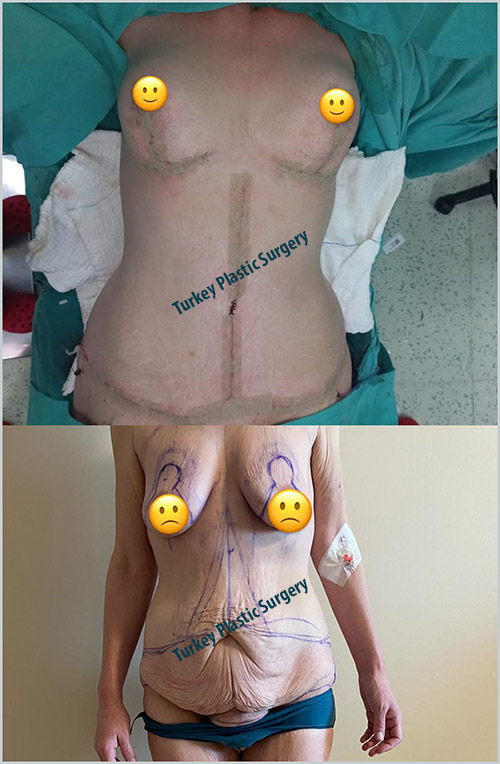In recent years, as the obesity rate in the society has increased, the interest in weight loss surgeries for the stomach and intestines, which we call bariatric surgery, has also increased. In our country, these surgeries have become much more common.
While the patient loses weight rapidly after bariatric surgery, sagging can occur at very high levels since the skin and subcutaneous tissues cannot respond to this saggins at the same rate.
At what stage is weight loss of interest to plastic surgery?

If there is no significant change in weight (half a kilo or 1 kilo per month) in the last six months, it means that it has become stable, and we can say that it has entered our limits.
However, in this case, it will be necessary to calculate the body mass index (BMI). If the patient has not lost enough weight, it may not be within our limits. The higher the BMI, the more post-operative complications will increase.
Although there are no clear criteria, the risk of BMI above 30 kg / square meter increases, it is quite evident above 35 kg / square meter. If the BMI has been high for a long time and does not tend to decrease after bariatric surgery, it would be beneficial to consult with the general surgeon and endocrinology specialists before plastic surgery.
Weight loss after bariatric surgery leads to loss of subcutaneous adipose tissue, thinning of the skin, and decreased elasticity. This causes excess skin, especially in the abdomen, back, breasts, arms, thighs and face, thus sagging. As might be expected, the most prominent areas of sagging are the abdomen and back. Some vitamin and mineral deficiencies are supplemented as absorption from the stomach and intestines changes.
However, since other structural elements such as subcutaneous collagen and elastin are not in sufficient quantity and function, problems may occur in the wound healing process.
The most important issue in the patient who needs body recovery is PLANNING. Due to the challenging conditions of health tourism, where combined surgeries are more frequent, many regions tend to be operated at the same time. It is useful to consider a number of factors when making a decision. The first of these is age. Combined surgery over the age of 70 may not be suitable. Another important parameter is the patient’s preoperative hemoglobin level. It should be at the appropriate level for the planned surgery.
Since combined surgeries take a long time, it is also important to manage the complications that may occur. Safety criteria for liposuction can be applied here as well (not including areas larger than 30% of the body, not exceeding 5% of the weight).
If the face is to be included, applying total body recovery in 3 stages will increase patient safety. Otherwise, two phases are planned to be held with a minimum interval of 3 months. Which ones to combine or the order of priority is decided between the surgeon and the patient. In general, the abdomen, back and breast are recovered in the first operation, while the arms and thighs are left for the second operation.
The scars that will remain after the operation are determined by discussing with the patient. For example, tummy tuck scars are only in the front and inside the underwear in classical abdominoplasty.
It will leave a vertical scar in the midline in addition to the classical scar in a belt lipectomy 360 degrees, and in fleur de lis (french tulip) abdominoplasty. If waist grooves are desired, the cost of this will be the vertical scar on the midline of the abdomen. Otherwise, while the excess skin in the lower region is repaired, the vertical excess will remain and the side cavities will remain relatively obscure.
The same is true for the breast. Their udders are generally highly ptotic, hollow and have skin cracks and are of poor quality. Since there is no breast tissue to bear weight, an additional prosthesis is usually not used. Complication and reoperation rate is very high when used. Even if the result is satisfactory, it will not take long.
Lifting results in a largely inverted T incision scar. The more excess skin, the longer the scar.
After the sagging skin removed from the arms, it usually results in a scar that starts from the elbow and extends to the armpit and remains on the inside when the arms are closed. The benefit obtained is the normalization of the arm diameter and the elimination of sagging.
Thigh lift can be planned together with tummy tuck or arm lift. If the sagging has spread to the middle and lower parts of the thigh, it will not be enough to remove only the crescent-shaped skin from the groin area. In this case, another vertical scar in the form of a torch will need to be left in the inner midline of the thigh. In this case, the reward is; It is the removal of sagging, especially in the inner region, by getting rid of the excess skin of the thigh. The inner surface of the thigh is rich in lymph drainage. Although wound opening is common in the suture lines due to wetness and tension, they heal with dressings without the need for additional intervention.
Post-operative follow-up and reactivity are important. Depending on the hemoglobin levels, blood transfusion may be required. Intravenous iron therapy at moderate levels accelerates general recovery and reduces fatigue. Warming the patient, early management, fluid therapy, anticoagulant therapy are very important in reducing the risk of deep vein thrombosis and embolism.
Care should be taken to prevent hypothermia and the operation time should not be too long.
As a result, total body recovery surgeries allow the patient to be at peace with himself again. The bad appearance caused by excess skin and sagging eliminates conditions such as diaper rash and is quite pleasing.

